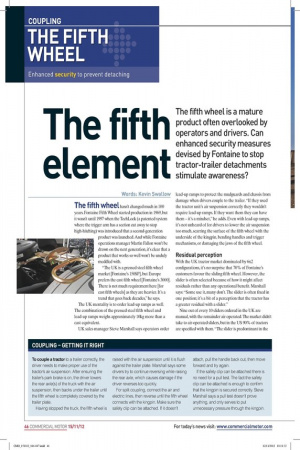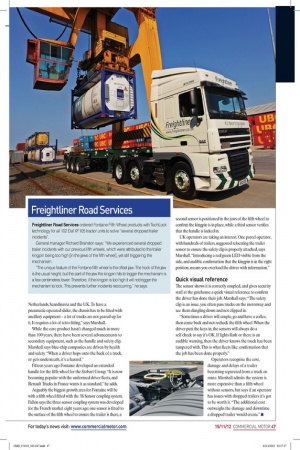The fifth element
Page 36

Page 37

If you've noticed an error in this article please click here to report it so we can fix it.
The fifth wheel is a mature product often overlooked by operators and drivers. Can enhanced security measures devised by Fontaine to stop tractor-trailer detachments stimulate awareness?
Words: Kevin Swallow
The fifth wheel hasn’t changed much in 100 years. Fontaine Fifth Wheel started production in 1969, but it wasn’t until 1997 when the TechLock (a patented system where the trigger arm has a section cut away to stop high-hitching) was introduced that a second-generation product was launched. And while Fontaine operations manager Martin Fallon won’t be drawn on the next generation, it’s clear that a product that works so well won’t be unduly meddled with.
“The UK is a pressed steel fifth wheel market [Fontaine’s 150SP], but Europe prefers the cast fifth wheel [Fontaine’s 3000]. There is not much requirement here [for cast fifth wheels] as they are heavier. It’s a trend that goes back decades,” he says.
The UK mentality is to order lead-up ramps as well. The combination of the pressed steel fifth wheel and lead-up ramps weighs approximately 10kg more than a cast equivalent.
UK sales manager Steve Marshall says operators order lead-up ramps to protect the mudguards and chassis from damage when drivers couple to the trailer. “If they used the tractor unit’s air suspension correctly they wouldn’t require lead-up ramps. If they want them they can have them – it’s a mindset,” he adds. Even with lead-up ramps, it’s not unheard of for drivers to lower the air suspension too much, scarring the surface of the fifth wheel with the underside of the kingpin, bending handles and trigger mechanisms, or damaging the jaws of the fifth wheel.
Residual perception
With the UK tractor market dominated by 6x2 configurations, it’s no surprise that 70% of Fontaine’s customers favour the sliding fifth wheel. However, the slider is often selected because of how it might affect residuals rather than any operational benefit. Marshall says: “Some use it, many don’t. The slider is often fixed in one position; it’s a bit of a perception that the tractor has a greater residual with a slider.” Nine out of every 10 sliders ordered in the UK are manual, with the remainder air-operated. The market didn’t take to air-operated sliders, but in the US 90% of tractors are specified with them. “The slider is predominant in the Netherlands, Scandinavia and the UK. To have a pneumatic-operated slider, the chassis has to be fitted with ancillary equipment – a lot of trucks are not geared up for it. It requires a lot of retro fitting,” says Marshall.
While the core product hasn’t changed much in more than 100 years, there have been several advancements to secondary equipment, such as the handle and safety clip. Marshall says blue-chip companies are driven by health and safety. “When a driver hops onto the back of a truck, or gets underneath, it’s a hazard.” Fifteen years ago Fontaine developed an extended handle for the fifth wheel for the Stobart Group. “It is now becoming popular with the uniformed driver fleets, and Renault Trucks in France wants it as standard,” he adds.
Arguably the biggest growth area for Fontaine will be with a fifth wheel fitted with the 3S Sensor coupling system. Fallon says the three-sensor coupling system was developed for the French market eight years ago; one sensor is fitted to the surface of the fifth wheel to ensure the trailer is there, a second sensor is positioned in the jaws of the fifth wheel to confirm the kingpin is in place, while a third sensor verifies that the handle is locked in.
UK operators are taking an interest. One parcel operator, with hundreds of trailers, suggested relocating the trailer sensor to ensure the safety clip is properly attached, says Marshall. “Introducing a red/green LED visible from the side, and audible confirmation that the kingpin is in the right position, means you overload the driver with information.”
Quick visual reference
The sensor shows it is correctly coupled, and gives security staff at the gatehouse a quick visual reference to confirm the driver has done their job. Marshall says: “The safety clip is an issue, you often pass trucks on the motorway and see them dangling down and not clipped in.
“Sometimes a driver will couple, go and have a coffee, then come back and not recheck the fifth wheel. When the driver puts the keys in, the sensors will always do a self-check to say it’s OK. If lights flash or there is an audible warning, then the driver knows the truck has been tampered with. This is what fleets like: confirmation that the job has been done properly.” Operators recognise the cost, damage and delays of a trailer becoming separated from a truck en route. Marshall admits the system is more expensive than a fifth wheel without sensors, but says if an operator has issues with dropped trailers it’s got to be worth it. “The additional cost outweighs the damage and downtime a dropped trailer would create.” ■
COUPLING – GETTING IT RIGHT
To couple a tractor to a trailer correctly, the driver needs to make proper use of the tractor’s air suspension. After ensuring the trailer’s park brake is on, the driver lowers the rear axle(s) of the truck with the air suspension, then backs under the trailer until the fifth wheel is completely covered by the trailer plate.
Having stopped the truck, the fifth wheel is raised with the air suspension until it is flush against the trailer plate. Marshall says some drivers try to continue reversing while raising the rear axle, which causes damage if the driver reverses too quickly.
For split coupling, connect the air and electric lines, then reverse until the fifth wheel connects with the kingpin. Make sure the safety clip can be attached. If it doesn’t attach, pull the handle back out, then move forward and try again.
If the safety clip can be attached there is no need for a pull test. The fact the safety clip can be attached is enough to confirm that the kingpin is secured correctly. Steve Marshall says a pull test doesn’t prove anything, and only serves to put unnecessary pressure through the kingpin.
Freightliner Road Services
Freightliner Road Services ordered Fontaine Fifth Wheel products with TechLock technology for all 102 Daf XF105 tractor units to solve “several dropped trailer incidents”.
General manager Richard Branston says: “We experienced several dropped trailer incidents with our previous fifth wheels, which were attributed to the trailer kingpin being too high [in the jaws of the fifth wheel], yet still triggering the mechanism.
“The unique feature of the Fontaine fifth wheel is the offset jaw. The hook of the jaw is the usual height, but the part of the jaw the kingpin hits to trigger the mechanism is a few centimetres lower. Therefore, if the kingpin is too high it will not trigger the mechanism to lock. This prevents further incidents reoccurring,” he says.









































